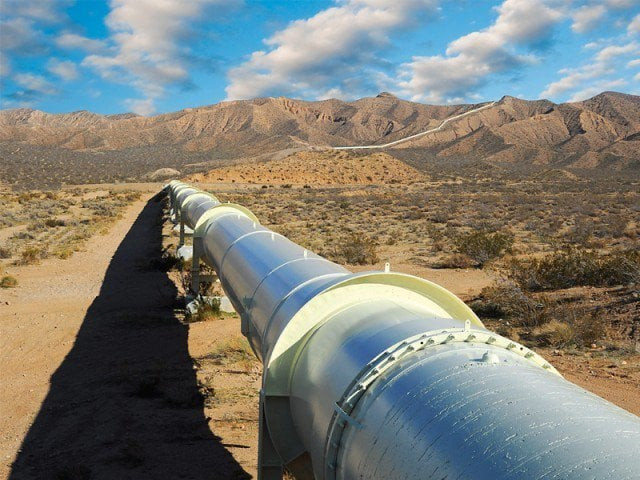Pakistan needs to double gas production in 5-7 years
Next govt must cut generation cost, restrict imports and focus on clean energy

Imported energy will have to be converted into local resources and immediate priority will have to be given to boost local gas production. We have abundant gas resources.
PHOTO: FILE
Hence, we would like to identify some of the most required issues and priorities for their consideration.
The Pakistan Muslim League-Nawaz (PML-N) government accomplished a number of things in the energy sector - 10,000 megawatts of generation capacity to come on line soon, some of which is already there; double-edged sword of liquefied natural gas (LNG), which solves short-term problems, but generates long-term liabilities and other energy projects under the China-Pakistan Economic Corridor (CPEC).
Punjab displaces Sindh as largest consumer of gas
The downside of its achievements is the expected high cost of generation, dependence on imported fuel, possible debt trap, lack of due attention to transmission and distribution capacity, and not to talk of circular debt and theft which feed each other.
Now, it is abundantly getting clear that the cost of generation under CPEC projects is high and some renegotiation may have to take place for the whole CPEC framework under constructive engagement with the Chinese.
It was pointed out earlier that engineering, procurement and construction (EPC) cost of the Jamshoro coal power plant was estimated at half that of similar CPEC projects. Recently, tenders have been invited by the Egyptian government for the award of a 6,000MW coal power plant package. Similar bids have been received at half the value of similar CPEC projects. Ironically, the minimum bidders are Chinese Shanghai and Dongfeng joint ventures.
The levellised cost of generation is coming out to be 4.5 US cents as opposed to 8.5 US cents for similar CPEC projects. Thus, renegotiation of CPEC project terms should be the next government’s priority.
Growing gas demand can be tackled by building storages in Pakistan
To be balanced and fair, however, one would like to commend the lower capital costs of natural gas combined cycle (NGCC) projects.
Secondly, transmission and distribution problems will grow as more generation capacity is commissioned. Already, we are seeing the problems with the partial induction of generation capacity.
Theft is an associated issue, although I am quite pessimistic about a short-term solution except for some improvements that may be possible under improved governance. It is partly an issue of power structure, poverty and affordability.
Domestic resources
Thirdly, priority action will be required to develop local energy resources. Imported coal and LNG-based NGCC power plants will create some major foreign exchange issues with addition of $5 billion per year in imports, though the close of furnace oil plants may somewhat ameliorate it.
Imported energy will have to be converted into local resources and immediate priority will have to be given to boost local gas production. We have abundant gas resources.
SSGC fears reduced gas supply to consumers in summer
We are victims of a go-slow style of management in two public-sector companies - Oil and Gas Development Company (OGDC) and Pakistan Petroleum Limited (PPL). They have done some work, but it is not enough.
Russians may be able to help who are very good in this sector. Local investors may have to be brought in, some of whom are already doing very well. Gas production will have to be doubled in the next five to seven years.
Local gas is getting depleted and demand is increasing. A demand for 8 to 10 billion cubic feet per day (bcfd) is expected by 2030 against current production level of 3.8 bcfd.
A reappraisal of energy projects in pipeline will have to be done and some rescheduling and adjustments will be required to reflect cost reduction and foreign exchange savings and where political considerations appear to be paramount than economic requirements.
Addition of more imported coal power plants has to be resisted firmly including the NGCC plants in Punjab. There are many powerful parties in Punjab which have been lobbying for a few more of these.
The biggest problem of the government is political decision-making in this respect manoeuvred by vested interests. Independent power plants, on imported fuels particularly, are the best investment. Some activity and marginal investment is required and our generations will benefit.
Renewable energy
Under this imperative of reducing energy imports, a major initiative for the injection of solar and may be wind power may have to be launched. Solar power had been ignored by the PML-N government after launching some expensive projects like the Quaid-e-Azam solar park.
However, solar power prices have come down tremendously, almost half that of fossil-based plants. They are at 4-5 cents and available throughout the territory and close to where the consumer is located, reducing the need for expensive associated transmission.
A 10,000MW solar or solar-wind package including hybrid solar and wind will have to be developed and implemented on a fast-track basis. Instead of launching big solar projects, smaller plants should be built at an average of 100MW at 100 locations.
Some fossil and even hydroelectric power projects may have to be delayed to balance the resource requirements. Hydroelectric power is expensive now at 9 cents as opposed to the popular notion of cheap hydel electricity of Rs1 and requires large lead time.
This is not to suggest restriction on hydroelectric power, but some dilution certainly. One can install twice as many power plant capacities with solar power.
Restricting generation cost
The investment rationing criterion at least for the next five years should not exceed Rs6 per kilowatt-hour (kWh), if we want to reduce the cost of generation to a level that brings back competiveness in the industrial sector.
The textile sector claims to have a potential for $60 billion worth of exports, may be somewhat exaggerated for the time being, but worth pursuing through enabling costs and environment. A lower generation cost will also bring down consumer tariff, reducing the incentive for theft. Smaller provinces have been complaining of iniquitous distribution of energy resources and investments and lack of adequate role and consultation in important decision-making. There is a lack of clear principles and criteria in distribution and sharing.
These are indeed difficult issues. A major decision will have to be taken to either reform the federal system or give provinces energy autonomy on the lines of other federations like India, the US, Australia, etc.
An associated issue is the governance of public enterprises in the energy sector and privatisation, mergers or divisions. All public-sector companies are embroiled in corruption and theft, resulting in unacceptable losses, especially for power distribution companies and gas companies.
Governance reforms, privatisation or restructuring options would have to be adopted. Many studies and reports are available for action in this respect. Finally, the merit and efficacy of genuine competition must be recognised and followed. Examples are abundant. We have given examples of the Egyptian coal project, Pakistan’s Jamshoro plant and NGCC projects where very reasonable costs have been planned through competition.
Also LNG prices agreed through competition were 13% lower than that negotiated with Qatar.
Regulators have almost failed to perform their duties given the political environment that prevails. Regulation may have to be replaced by energy exchanges, eventually. Regulators may monitor the competition regime.
Concluding, economic and rational decision-making with lesser regard for, if not totally devoid of, immediate political consideration and constituency politics and disproportionate provincial considerations, would be required in this sector and probably in all other sectors.
The next five years should be for balancing and mending policies of the past five years wherever required and should not be for pursuing vendetta trying to undo whatever good and bad may have been done.
The writer is former member energy of the Planning Commission.
Published in The Express Tribune, June 25th, 2018.
Like Business on Facebook, follow @TribuneBiz on Twitter to stay informed and join in the conversation.



















COMMENTS
Comments are moderated and generally will be posted if they are on-topic and not abusive.
For more information, please see our Comments FAQ